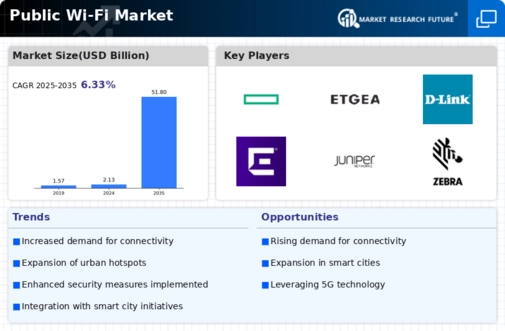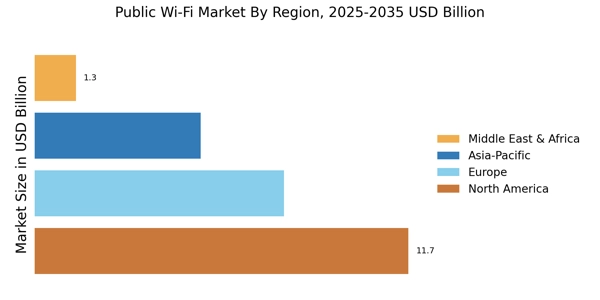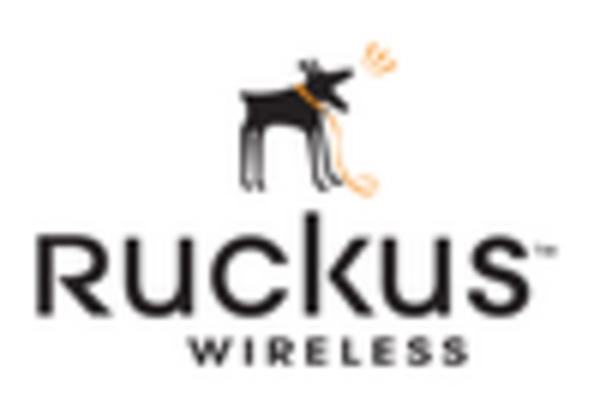Rise of Smart Cities
The emergence of smart cities significantly influences the Public Wi-Fi Market. As urban areas evolve into interconnected ecosystems, the integration of public Wi-Fi networks becomes essential for facilitating communication between devices and services. Smart city initiatives often prioritize the deployment of public Wi-Fi to support various applications, such as traffic management, public safety, and environmental monitoring. Data indicates that cities investing in smart technologies are likely to see a 30% increase in public Wi-Fi usage, as residents and visitors seek reliable internet access to engage with these services. This trend underscores the importance of public Wi-Fi as a foundational element of smart city infrastructure. Consequently, the Public Wi-Fi Market is expected to thrive as municipalities recognize the value of providing comprehensive connectivity solutions to enhance urban living.
Increased Demand for Connectivity
The Public Wi-Fi Market experiences a notable surge in demand for connectivity as urbanization accelerates. With more individuals relying on internet access for work, education, and leisure, the need for public Wi-Fi networks becomes increasingly critical. Recent data indicates that approximately 70% of consumers prefer locations with free Wi-Fi, which drives businesses and municipalities to invest in public access points. This trend suggests that the Public Wi-Fi Market is poised for growth, as stakeholders recognize the necessity of providing reliable internet access to enhance customer satisfaction and engagement. Furthermore, the proliferation of mobile devices and the Internet of Things (IoT) amplifies this demand, as users expect seamless connectivity in public spaces. Consequently, the Public Wi-Fi Market is likely to expand significantly in response to these evolving consumer preferences.
Government Initiatives and Funding
Government initiatives play a pivotal role in shaping the Public Wi-Fi Market. Various governments are increasingly recognizing the importance of digital inclusion and are implementing policies to expand public Wi-Fi access. For instance, funding programs aimed at enhancing broadband infrastructure have been established, with billions allocated to improve connectivity in underserved areas. This financial support not only facilitates the deployment of public Wi-Fi networks but also encourages private sector participation. As a result, the Public Wi-Fi Market benefits from a collaborative approach that combines public funding with private innovation. Moreover, these initiatives often focus on enhancing digital literacy, which further stimulates demand for public Wi-Fi services. The ongoing commitment from governments to bridge the digital divide suggests a robust future for the Public Wi-Fi Market, as more communities gain access to essential internet services.
Growing Importance of Customer Experience
In the competitive landscape of the Public Wi-Fi Market, enhancing customer experience emerges as a crucial driver. Businesses and service providers increasingly understand that offering free Wi-Fi can significantly improve customer satisfaction and retention. Research indicates that establishments providing public Wi-Fi see a 50% increase in customer dwell time, which translates to higher sales and brand loyalty. This realization prompts various sectors, including retail, hospitality, and transportation, to invest in robust public Wi-Fi solutions. Furthermore, the ability to collect data on user behavior through public Wi-Fi networks allows businesses to tailor their services and marketing strategies effectively. As customer expectations evolve, the Public Wi-Fi Market is likely to adapt by offering more personalized and engaging experiences, thereby solidifying its role in enhancing overall customer interactions.
Technological Advancements in Network Infrastructure
Technological advancements in network infrastructure are reshaping the Public Wi-Fi Market. Innovations such as 5G technology and mesh networking are enhancing the performance and reliability of public Wi-Fi services. The deployment of 5G networks, for instance, offers significantly higher speeds and lower latency, which can transform the user experience in public spaces. Data suggests that areas equipped with advanced network infrastructure may experience a 40% increase in user satisfaction. Additionally, the integration of mesh networks allows for broader coverage and improved connectivity in densely populated areas. These advancements not only attract more users but also encourage businesses to invest in public Wi-Fi solutions. As technology continues to evolve, the Public Wi-Fi Market is expected to benefit from enhanced service offerings and increased user engagement.


















Leave a Comment